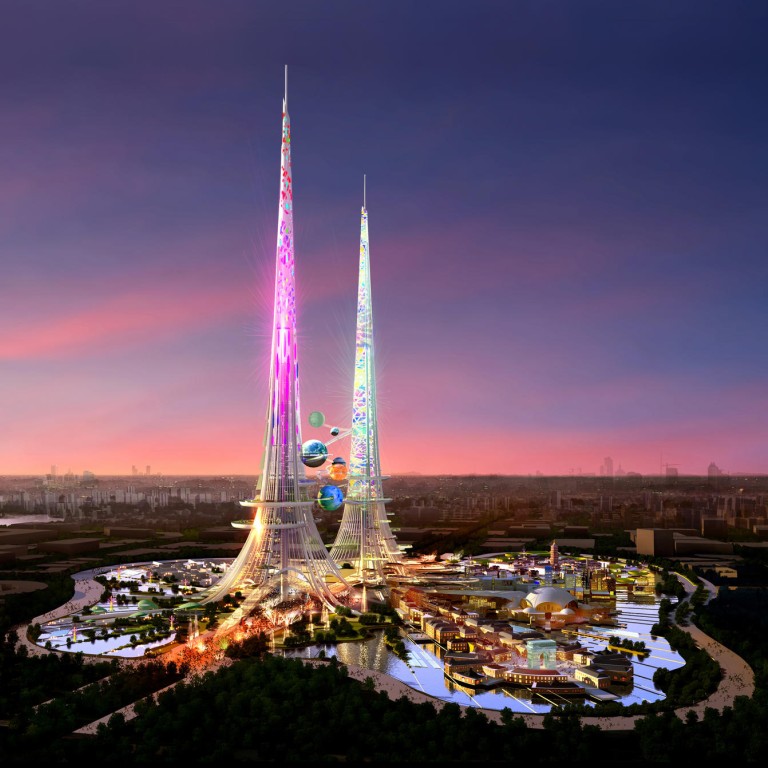
Mainland China towers scraping the sky in a green and modern way
The mainland's enthusiastic construction of towers is leading to the use of building methods which are cleaner and even anti-pollution
At the rate the mainland is putting up buildings, more than 1,500 skyscrapers of 30 storeys or taller - equivalent to the whole city of Chicago - are being constructed every year, research by McKinsey & Co, a global management consulting firm, shows.
The mainland's "cookie-cutter approach" to large-scale rapid development, as Jonathan Woetzel, a Shanghai-based director at McKinsey, puts it, has hardly been inspirational - not to mention the environmental impact.
The tide is turning, though. At the behest of more enlightened local governments, international architecture firms are introducing alternatives that could see the mainland tackle its pollution problems, from the ground up.
According to the United States Green Building Council, China is home to some of the most ambitious Leadership in Energy and Environmental Design (LEED)-certified buildings in the world. Close to 2,000 LEED projects on the mainland, in Hong Kong, Taiwan and Macau, representing 110 million gross square metres, make this region the world's second-largest market for LEED, after the US, according to the report.
The mainland also claims the first building to achieve LEED version 4, the rating system's latest iteration, which places a deep emphasis on building performance and human health.
That honour goes to The Club, completed in May 2013, the Beijing office and showroom of Haworth, a global furniture design and manufacturer. In order to achieve the certification, everything from the location of The Club - within the landmark Parkview Green, itself a LEED Platinum (version 3) development - and its energy performance, to water efficiency and indoor air quality, had to be considered.
The design features extensive use of reclaimed oak and kirei (a sustainable substitute for wood similar to bamboo) for non-structural elements, such as walls and flooring.
"Additionally, 93 per cent [by value] of the furniture in the space is either Greenguard certified, or has been transferred from our previous showroom," says Iolanda Meehan, director of strategic services for Haworth's Asia-Pacific sector. "Fresh air exceeds the required Indoor Environment Quality by 35 per cent."
Energy and water efficiencies also helped achieve the certification. Through the optimisation of the heating, ventilation and air-conditioning system, as well as efficient LED lighting, energy consumption in the new showroom was 59 per cent lower than the green standards required by ASHRAE (which provides guidance for meeting minimum energy efficiency requirements in buildings).
In Hangzhou, environmental concerns led US-based architecture practice NBBJ and local partner CCDI to employ the latest environmental advancements to build an Olympic-sized sports stadium of comparable scale to Beijing's national stadium, Herzog & de Meuron's Bird's Nest, only uses far less steel. Steelmaking is one of the world's leading industrial sources of greenhouse gases: production of a tonne of steel generates almost two tonnes of CO 2, and more than 1.6 billion tonnes of steel are produced every year, 45 per cent of it in the Chinese mainland.
Another factor is the cost. As worldwide demand for steel increases so does the price of its main component iron ore.
"That's why we use parametric design to cut waste while creating functionality and form," says Robert Mankin, lead architect on the Hangzhou Stadium, of a design that "conservatively" cuts steel use by half compared to the Bird's Nest.
Parametric design is hailed as the new age of architectural thinking. Based on algorithms, it enables architects to test models at every stage of the construction life cycle, allowing design changes to be made quickly, and eliminating the "build-test-discard" method common in traditional modelling.
For Hangzhou Stadium, this meant that the steel shell and concrete bowl systems could be coordinated and linked for stability, thus optimising steel use. On the exterior façade, lightweight perforated cladding fabricated as repetitive modular components produced further materials savings.
By situating the stadium within a park, the building's heat island effect is reduced. Incorporating a retail component also means the building will be used on non-event days, maximising its usage. The pair of skyscrapers British firm Chetwoods has designed for Wuhan will be, at 1km high, not only the world's tallest twin towers, but will actively "eat" urban pollution, filtering the air through bio-dynamic pollution-absorbing coatings.
Laurie Chetwood, chairman of Chetwoods, calls Phoenix Towers "a genuine game-changer for urban design". Such sophisticated materials are being trialled in projects worldwide. He adds that this may well be a first for the mainland.
"Technologies already developed include titanium-dioxide based nano-particle coatings that can be applied to surfaces to absorb and neutralise pollution, using ambient sunlight, water and oxygen to react with and neutralise urban air pollutants such as nitrogen dioxide, breaking them down into less noxious compounds." These projects show just how far environmental technologies have come in the past decade.
In today's China, says Mankin, the goal of lowering a building's embodied energy - all the energy consumed in its making, from the sourcing of raw materials to their manufacture into building products; from their transport on site to power tools and machinery used in the build, and even the longevity of the building itself - has become part of the construction dialogue.

